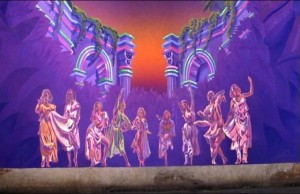What is the source of creativity? Why are some people creative, and others not as much? To those who aren’t, creative people can seem imbued with magical power, able to see beyond, and to make something out of nothing.
The ancient Greeks judged many such abilities to be god-given, and attributed creativity to the Muses. Later Greek mythology settled on their being nine of them, all goddesses, and all daughters of Zeus and Mnemosyne. Each was an expert in some field or group of related fields. Though a muse might inspire a certain level of skill in a mortal, woe be unto the mortal who dared to challenge a muse herself.
I’ve blogged several times (notably here, here, and here) about muses, since I’m interested in creativity and enjoy the idea of somehow making that mysterious attribute more tangible and understandable. In my own uncreative moments, when stumped for a story idea, I wonder if I’d be more creative if I had a muse figurine. If I stared at such a figurine, would the muse herself inspire me?
 Guilty pleasure confession: I liked the 1980 movie Xanadu, especially the scene where the nine muses emerge from a wall mural, to the tune of the wonderfully exuberant song “I’m Alive,” by the Electric Light Orchestra.
Guilty pleasure confession: I liked the 1980 movie Xanadu, especially the scene where the nine muses emerge from a wall mural, to the tune of the wonderfully exuberant song “I’m Alive,” by the Electric Light Orchestra.
For today, I thought I’d ponder the various fields mastered by the ancient muses, and see how we would update that and assign modern creative fields to 21st Century muses.
Here are the classical muse job assignments:
| Muse Name | Domain |
| Calliope | Epic poetry |
| Clio | History |
| Euterpe | Music, Song, and Elegiac Poetry |
| Erato | Lyric poetry |
| Melpomene | Tragedy |
| Polyhymnia | Hymns |
| Terpsichore | Dance |
| Thalia | Comedy |
| Urania | Astronomy |
Today, I’m not sure we’d count History or Astronomy as being such creative endeavors as to be each worth having their own muse. Also, I doubt we’d split poetry three ways. Note that prose fiction (my preferred field) is nowhere on the list.
Here’s my initial attempt to modernize the muses, taking into account the different and newer creative endeavors available today:
|
Muse Name |
Domain |
| Alpha | Literary arts (fiction, poetry) |
| Euphemia | Performing arts (music, dance, choreography, theater, movies, singing, comedy) |
| Idola | Visual arts (painting, sculpture, photography, architecture, interior design) |
| Mágeira | Gastronomy / chef |
| Polycassandra | Multimedia artistic works (comics, video games) |
My list has only five, not nine. But even ancient accounts weren’t clear about the number of muses.
I stuck with the idea of giving them Grecian names (or feminized versions of Greek words). Alpha is, of course, the first letter. Euphemia means to speak or declare. Idola means vision. Mágeira is intended to refer to chefs and cooking. Polycassandra is intended to mean manifold helper.
Perhaps in a future blog post I’ll re-examine this list. I might be able to split up their duties in a way to better even out their workload. After all, Idola and Euphemia would be very busy, compared to Mágeira.
What do you think? Have I left out any creative fields of endeavor worthy of inclusion? Is there a better way to organize the assignments? In the task of modernizing the muses, it’s time for you to get creative and to out-do—
Poseidon’s Scribe
